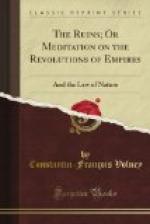the Tongouse, with his horned cap, and carrying his
idols pendant from his neck; the Yakoute, with his
freckled face; the Kalmuc, with his flat nose and
little retorted eyes. Farther distant were the
Chinese, attired in silk, with their hair hanging in
tresses; the Japanese, of mingled race; the Malays,
with wide-spreading ears, rings in their noses, and
palm-leaf hats of vast circumference;* and the tattooed
races of the isles of the southern ocean and of the
continent of the antipodes.** The view of so many
varieties of the same species, of so many extravagant
inventions of the same understanding, and of so many
modifications of the same organization, affected me
with a thousand feelings and a thousand thoughts.***
I contemplated with astonishment this gradation of
color, which, passing from a bright carnation to a
light brown, a deeper brown, dusky, bronze, olive,
leaden, copper, ends in the black of ebony and of
jet. And finding the Cassimerian, with his rosy
cheek, next to the sun-burnt Hindoo, and the Georgian
by the side of the Tartar, I reflected on the effects
of climate hot or cold, of soil high or low, marshy
or dry, open or shaded. I compared the dwarf of
the pole with the giant of the temperate zones, the
slender body of the Arab with the ample chest of the
Hollander; the squat figure of the Samoyede with the
elegant form of the Greek and the Sclavonian; the
greasy black wool of the Negro with the bright silken
locks of the Dane; the broad face of the Kalmuc, his
little angular eyes and flattened nose, with the oval
prominent visage, large blue eyes, and aquiline nose
of the Circassian and Abazan. I contrasted the
brilliant calicoes of the Indian, the well-wrought
stuffs of the European, the rich furs of the Siberian,
with the tissues of bark, of osiers, leaves and feathers
of savage nations; and the blue figures of serpents,
flowers, and stars, with which they painted their
bodies. Sometimes the variegated appearance of
this multitude reminded me of the enamelled meadows
of the Nile and the Euphrates, when, after rains or
inundations, millions of flowers are rising on every
side. Sometimes their murmurs and their motions
called to mind the numberless swarms of locusts which,
issuing from the desert, cover in the spring the plains
of Hauran.
* This species of the palm-tree is called Latanier. Its leaf, similar to a fan-mount, grows upon a stalk issuing directly from the earth. A specimen may be seen in the botanic garden.
** The country of the Papons of New Guinea.
*** A hall of costumes in one of the galleries of the Louvre would, in every point of view, be an interesting establishment. It would furnish an admirable treat to the curiosity of a great number of persons, excellent models to the artist, and useful subjects of meditation to the physician, the philosopher and the legislator.
Picture to yourself a collection of the various faces and figures of every country




